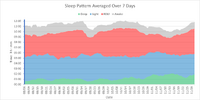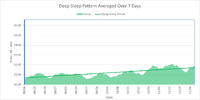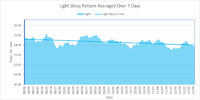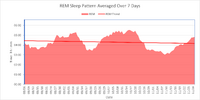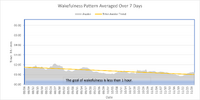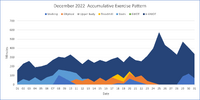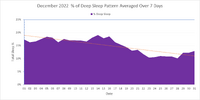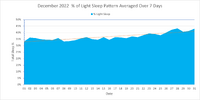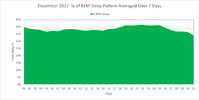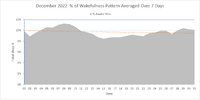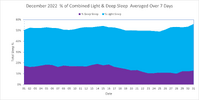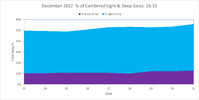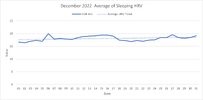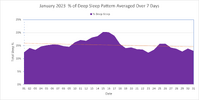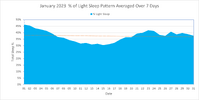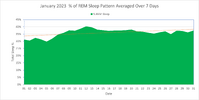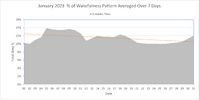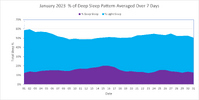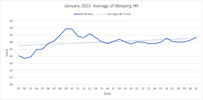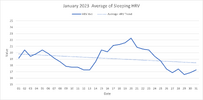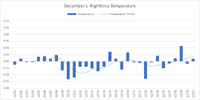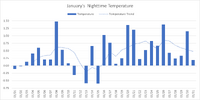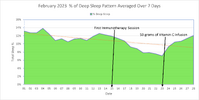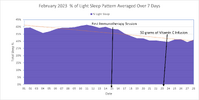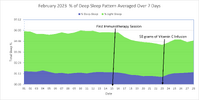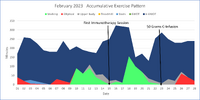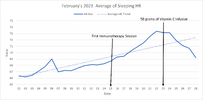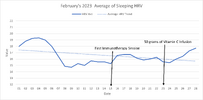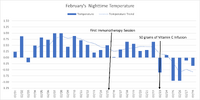I am building my strength and energy after a rapid loss of both in January 2022 and my melanoma diagnosis. I expected faster progress, so I needed to do a full system analysis. I know that healing occurs best during deep sleep and my sleep has been adequate at best. I already optimized diet and exercise, so the weak point seems to be recovery during sleep. I also snore and suspect mild sleep apnea. Since I was unable to fully understand my inadequate healing sleep, I decided to buy an activity monitor to collect sleep data. With objective data I will understand how to tune up my sleep.
First, a refresher on why sleep is an important aspect of health and why deep sleep in particular is extremely valuable.
The gold standard of an objective sleep analysis is a clinical sleep study. The following website explains the details of such a study. Sleep Study
Because my sleep problems were mild, I chose a wearable activity monitor that would track my sleep and daily activities instead of doing a clinical sleep study. I chose the Ouraring (Oura Ring: Accurate Health Information Accessible to Everyone) because of its long battery life, low profile design, and multiple integrating features. I have been wearing the ring since July 29 which has given me enough data to work with.
The ouraring tracts the duration of sleep how long it takes to fall asleep, lowest heart rate, average heart rate, the strength of the heartbeat (HRV), respiratory rate, awake time, 3 sleep phases (REM, light sleep, deep sleep), temperature (delta), and restlessness (%). It then uses algorithms to give a sleep score of 0-100. To be sure such devices are not clinically accurate, but they do offer a window into activity trends. Wearable devices does provide a measure of objective analysis of activity and sleep patterns.
The initial data showed that I slept at least 11 hours, 1-3 hours of wakefulness, and less than an hour of deep sleep. I test different exercises, diet, supplementation, and oxygen therapy to change the pattern.
I need to increase the light and deep sleep cycles to 3-6 hours, reduce wakefulness to less than 1 hour, and reduce REM sleep to less than 2 hours. My preferred goal is 6+ hours of combined light and deep sleep with deep sleep more than 3 hours.
The following is the chart of my daily sleep pattern since July.
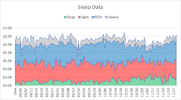
The chart of the raw sleep data does show a positive trend after the middle of October. I am acutely aware that exercise is the best way to improve sleep. Therefore, I have also been tracking my exercises to help understand what effect it has on sleep.
The following chart shows the time spent on different exercises by date.
EWOT=Exercise With Oxygen Therapy at a clinic with 100% oxygen at 20L flow rate. H-EWOT= Home EWOT with 95% oxygen at 15L flow rate.
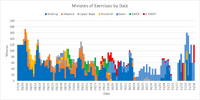
Towards the end of October, I added an hour of stairs 3-4 times per week, and it has improved my sleep patterns.
Since exercise has an accumulative effect on the body, I created a chart showing a 3-day accumulative exercise pattern.
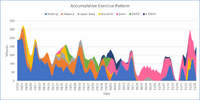
First, a refresher on why sleep is an important aspect of health and why deep sleep in particular is extremely valuable.
Basics of Sleep Cycles said:Sleep Basics: REM & NREM, Sleep Stages, Good Sleep Habits & More
REM sleep and Non REM
When you sleep, your brain goes through natural cycles of activity. There are four total stages of sleep, divided into two phases:As you sleep, your body cycles through non-REM and REM sleep. You usually start the sleep cycle with stage 1 of non-REM sleep. You pass through the other stages of non-REM sleep, followed by a short period of REM sleep. Then the cycle begins again at stage 1.
- Non-REM sleep happens first and includes three stages. The last two stage of non-REM sleep is when you sleep deeply. It’s hard to wake up from this stage of sleep.
- REM sleep happens about an hour to an hour and a half after falling asleep. REM sleep is when you tend to have vivid dreams.
A full sleep cycle takes about 90 to 110 minutes. Your first REM period is short. As the night goes on, you’ll have longer REM sleep and less deep sleep.
There three stages make up Non REM sleep.
Stage 1.This stage of very light sleeping lasts for five to 10 minutes.
- Everything starts to slow down, including your eye movement and muscle activity.
- Your eyes stay closed. If you get woken from stage 1 sleep, you may feel as if you haven’t slept at all. You may remember pieces of images.
- Sometimes, you may feel like you’re starting to fall and then experience a sudden muscle contraction. Healthcare providers call this motion hypnic myoclonic or hypnic jerk. Hypnic jerks are common and not anything to be concerned about as this occurrence is unlikely to cause any complications or side effects.
Stage 2.
- This period of light sleep features periods of muscle tone (muscles partially contracting) mixed with periods of muscle relaxation.
- Your eye movement stops, heart rate slows and body temperature decreases.
- Brain waves become slower. Occasionally, you’ll have a burst of rapid waves called sleep spindles.
- Your body prepares to enter deep sleep.
Stage 3. The healing and rejuvenation sleep stageAs we age, we get less non-REM sleep. To mitigate the deteriorating effects of aging it is necessary to work at improving deep sleep time.
- This stage is deep sleep.
- During this stage, your brain produces delta waves, very slow brain waves.
- It’s hard for someone to wake you up during this stage.
- You have no eye movement or muscle activity.
- If you’re woken up, you may feel groggy and disoriented for a few minutes.
Necessity of sleep especially stage 2 and more so of stage 3.In humans, sleep appears to be critical to both physical and mental development10 in babies, children, and young adults. In adults, a lack of sleep has been associated with a wide range of negative health consequences including cardiovascular problems11, a weakened immune system12, higher risk of obesity and type II diabetes13, impaired thinking and memory, and mental health problems like depression and anxiety.These diverse ramifications of sleep deprivation offer strong support to the view that sleep doesn’t have just one biological purpose but in fact, through its complexity, is an important contributor to the proper functioning of nearly all of the systems of the body.
Ways to Monitor sleep patternsEffects of sleep deprivation. Cleveland Clinic Website said:• Sleep Deprivation: What It Is, Symptoms, Treatment & Stages
Systems affected
Sleep deprivation has negative effects in multiple ways throughout your body. Those can affect the following body systems, organs and processes:
- Heart and circulatory systems: Sleep deprivation has long-term damaging effects on your heart and circulatory health. People with chronic sleep deprivation are more likely to develop high blood pressure (hypertension) and high cholesterol (hyperlipidemia).
- Metabolic systems: People with chronic sleep deprivation are at a much higher risk of developing Type 2 diabetes.
- Immune system: Your body’s natural defenses against infections can’t work properly if you aren’t getting enough sleep.
- Nervous system: It’s common for people who aren’t sleeping enough to have higher pain sensitivity, which means they feel pain more easily, the pain is more intense or both.
- Brain: Sleep deprivation has very negative effects on how your brain works. While experts don’t fully understand sleep’s role in brain function, they do know it’s a key part of how people learn and remember. There’s also some evidence that sleep deprivation could play a role in the development of Alzheimer’s disease.
- Mental health: Sleep deprivation also negatively affects your mental health, making it harder for you to manage and process your emotions. People with sleep deprivation are more likely to feel symptoms of depression and anxiety.
The effects of sleep deprivation depend on why it happens and how long it lasts. The longer a person has sleep deprivation, the greater — and more severe — the effects.
Conditions that can get worse or happen because of sleep deprivation
Sleep deprivation also increases your risk of developing certain conditions or making them worse if you have them. These conditions include:
• Type 2 diabetes.• High blood pressure (hypertension).• Obesity.• Obstructive sleep apnea.• Vascular disease.• Stroke.• Heart attack.• Depression.• Anxiety.• Conditions that involve psychosis.Symptoms and Causes
Sleep deprivation causes many symptoms. Some of the most common symptoms include:
• Daytime sleepiness.• Fatigue.• Irritability.• Trouble thinking, focusing and remembering.• Slowed reaction times.• Headaches.As sleep deprivation goes on for longer, the symptoms become more severe. Many of the more severe symptoms look like the effects of alcohol intoxication. The severe symptoms of sleep deprivation include:
• “Microsleeps” (when a person briefly falls asleep for only seconds before waking back up).• Uncontrollable eye movements (nystagmus).• Trouble speaking clearly.• Drooping eyelids (ptosis).• Hand tremors.• Visual and tactile (touch-based) hallucinations.• Impaired judgment.• Impulsive (or even reckless) behavior.Stages of sleep deprivation
Total sleep deprivation, which is when you aren’t getting any sleep, happens in stages. These stages are:
- Stage 1: This is when you go at least 24 hours without sleeping. In this stage, the effects of sleep deprivation are similar to being under the influence of alcohol to the point where it isn’t safe for you to drive.
- Stage 2: Common symptoms of sleep deprivation intensify. Most people start to experience microsleeps in this stage and have trouble thinking or focusing.
- Stage 3: People in this stage start to show very severe symptoms like hallucinations. They may also struggle to communicate with people around them.
- Stage 4: The symptoms of sleep deprivation are at their most extreme. The above symptoms worsen to severe or extreme levels. Hallucinations are common and you struggle to tell what’s real and what isn’t.
How to get more deep sleep.
- Avoid stimulants such as caffeine, decongestants, high dose B-vitamin, adrenaline rush activities, or herbal stimulants.
- Alcohol. Alcohol in small doses may be tolerated but can easily aggravate the body and reduce deep sleep.
- Napping can reduce deep sleep during the night.
- Exercise earlier in the day to give the body plenty of time to return to lower resting heart rate.
- Bright lights in the evening and any lights during the night have a negative effect on deep sleep.
- Computer screens and smart phones just before bed and during the night stimulates the nervous system.
- Consistent sleep schedule has an accumulative effect on sleep quality.
- If you do not fall asleep roughly between 15-20 minutes then get up, go to the bathroom, do stretching, write down what is on your mind and other relaxation activities until you feel sleepy.
- Turn off the brain by writing down what you need to do for tomorrow, make list of what you would like dream about, how you would like to behave in your dreams, problems that you would like help from your dreams.
- Seek professional help if all else fails.
The gold standard of an objective sleep analysis is a clinical sleep study. The following website explains the details of such a study. Sleep Study
Because my sleep problems were mild, I chose a wearable activity monitor that would track my sleep and daily activities instead of doing a clinical sleep study. I chose the Ouraring (Oura Ring: Accurate Health Information Accessible to Everyone) because of its long battery life, low profile design, and multiple integrating features. I have been wearing the ring since July 29 which has given me enough data to work with.
The ouraring tracts the duration of sleep how long it takes to fall asleep, lowest heart rate, average heart rate, the strength of the heartbeat (HRV), respiratory rate, awake time, 3 sleep phases (REM, light sleep, deep sleep), temperature (delta), and restlessness (%). It then uses algorithms to give a sleep score of 0-100. To be sure such devices are not clinically accurate, but they do offer a window into activity trends. Wearable devices does provide a measure of objective analysis of activity and sleep patterns.
The initial data showed that I slept at least 11 hours, 1-3 hours of wakefulness, and less than an hour of deep sleep. I test different exercises, diet, supplementation, and oxygen therapy to change the pattern.
I need to increase the light and deep sleep cycles to 3-6 hours, reduce wakefulness to less than 1 hour, and reduce REM sleep to less than 2 hours. My preferred goal is 6+ hours of combined light and deep sleep with deep sleep more than 3 hours.
The following is the chart of my daily sleep pattern since July.

The chart of the raw sleep data does show a positive trend after the middle of October. I am acutely aware that exercise is the best way to improve sleep. Therefore, I have also been tracking my exercises to help understand what effect it has on sleep.
The following chart shows the time spent on different exercises by date.
EWOT=Exercise With Oxygen Therapy at a clinic with 100% oxygen at 20L flow rate. H-EWOT= Home EWOT with 95% oxygen at 15L flow rate.

Towards the end of October, I added an hour of stairs 3-4 times per week, and it has improved my sleep patterns.
Since exercise has an accumulative effect on the body, I created a chart showing a 3-day accumulative exercise pattern.


